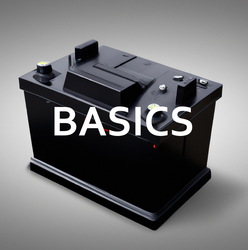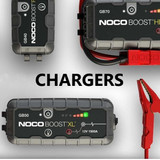Battery 101: Batteries, Defined
Batteries make stuff work – that’s what most people understand about batteries and how they work. But since the invention of the battery, scientists and engineers have not only developed better batteries (like AGM batteries), but have also created life changing machines that are dependent upon them.
To kickstart your battery education, check out some of the most basic battery terms.
Primary vs. Secondary Batteries
There are essentially two types of batteries, those that can be recharged and those that cannot.
- Primary Battery: a primary battery is made up of primary cells that cannot be recharged, however, they have a lifespan that is measured in years.
- Secondary Battery: a secondary battery is made up of storage cells that, once discharged, can be restored, or recharged. These batteries usually need to be recharged within a matter of months.
Primary batteries typically have a higher capacity than a secondary battery, but once it’s charge is spent, it must be replaced. Secondary batteries are gaining in popularity through their use in electric cars where it’s necessary to recharge regularly rather than replace.
Trickle Charging
Trickle charging is a method that is used with secondary batteries to help maintain their charge. This typically occurs through connecting the battery to a constant-current supply that will maintain the battery at a full charge.
Voltage
In the world of batteries, voltage is a big word that encompasses quite a few different meanings. Let’s break it down just a little.
- Voltage: loosely defined, voltage is the pressure from a power source, such as a battery, that pushes charged electrons through a loop, creating an electrical circuit.
- Open Circuit Voltage is the voltage measurement when the circuit is open or not drawing a load.
- Closed Circuit Voltage is the voltage measurement when the circuit is closed or is drawing a load.
- Nominal Voltage is the operating voltage for a particular circuit or battery system when fully charged.
- Cut-off Voltage (also known as end-point voltage) is the voltage level at which the connected equipment will no longer operate or is unsafe to attempt operation.
Why is this important? Simply put, the greater the voltage, the greater the flow of electrons producing more power.
Charge Capacity
The charge capacity also referred to simply as capacity, is the measurement of amp hours that can be withdrawn from a battery under a set of specific conditions. All other factors being equal, a battery with a higher capacity will have a longer runtime. Some factors that can affect the capacity of a battery are cut-off voltage, temperature, and discharge rate.
Discharge Rate
Discharge is the conversion process that changes the chemical energy of the battery into electric energy. There are different levels of discharge.
- High Discharge Rate is the withdrawal of large currents for a short period of time. High discharge rates typically deplete the battery within an hour.
- Low Discharge Rate is the withdrawal of small currents for longer intervals. This allows for battery usage in excess of an hour.
- Deep Discharge allows for withdrawal of electrical energy to the cut-off voltage before requiring recharging.
While this is far from everything worth knowing about batteries, it’s definitely a good place to start.
POPULAR ARTICLES
-
Get Ready for Spring: Golf-Cart Battery Care and Charging Tips
Jan 23, 2024Everyone’s guilty of some mistakes with their batteries. The results of these well-intentioned actio
-
Pocket Power: Best Features of Lithium-Ion Battery Boosters
Jan 23, 2024Every device today seems to have a battery. That statement isn’t an exaggeration either. In fact, it
-
Where You Can Drive Golf Carts
Jan 23, 2024It’s the peak of summer vacation time and everyone is wanting to take a golf cart and hit the roads



